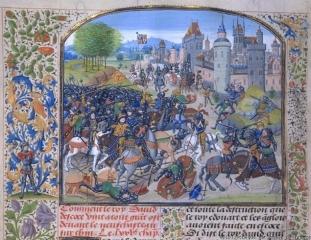| � |

|
| � |

|
The 15th century was a slightly more peaceful time for the castle, it was attacked only once, in 1460 when the army
of King James II of Scotland, attacking in support of the Lancastrian cause, took the castle and dismantled the
fortifications.
This illustration shows an imaginative illustration of the Countess of Salisbury leaving
Wark Castle in 1341, taken from the Chronicles of the historian Jean Froissart
(copyright of the Biblioth�que nationale de France, Paris.)
Find out about Wark Castle in the 16th century and
medieval archers, discover more about the legend of the
Order of the Garter or return to
the home page.
|
|
� |
Wark Castle: Wark Castle in 14th and 15th Centuries
The border fortresses played an important role during the campaigns of Edward I against the Scots. Edward stayed at
Wark for a week in November 1292 following his adjudication over the accession of the Scottish throne at Berwick. He
returned again in 1296 at the beginning of his campaign against Scotland. In 1300 he borrowed it for a year 'for the
safety of the March'.
Wark also figured frequently in the unsuccessful campaigns of Edward II against Robert Bruce. In 1314 Wark Castle was
used as a mustering point for an army to relieve the siege of Stirling Castle. Some 21,540 men, including a
contingency of 5000 Welsh archers, were called to join Edward at Wark on 10 June. It is not known how many of this
number actually reached the assembly point before Edward marched on 17 June on a journey that ended in the English defeat at Bannockburn.
In 1329 Wark castle passed to the Earl of Salisbury. It had been poorly maintained for a number of years before this
and was described at the time as 'ruined and broken'. During the almost constant border warfare of the late 14th
century Wark suffered considerably. An indenture of 1383 describes how
noblemen from both sides of the Border met at Wark to estimate the cost of repairs following a recent capture.
In 1390 the whole property was worth nothing and the castle lay in ruins. Sir
Thomas Grey acquired the property in 1398 but the following year the Scots 'took his castle, robbed his goods to the
value of �2000, put his infants and people to ransom for �1000, burned his houses and beat down his castle walls'.
|
� |
|
 |